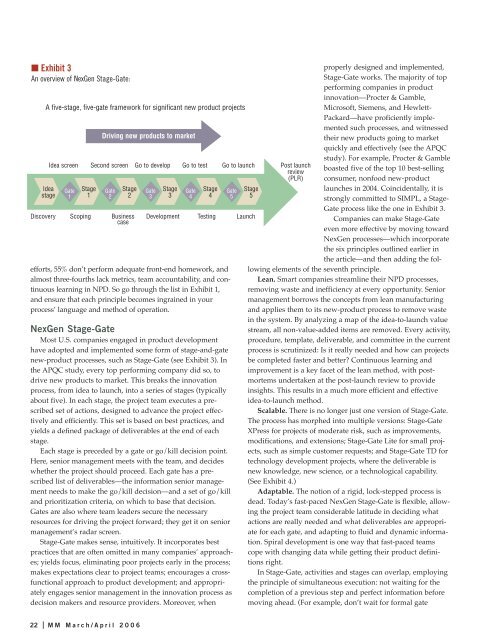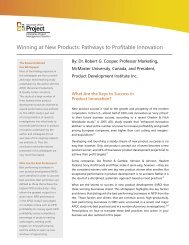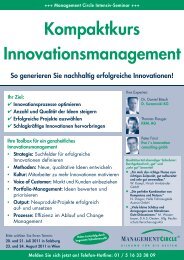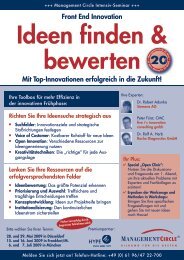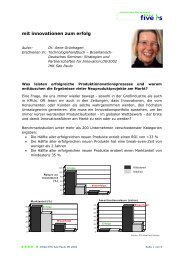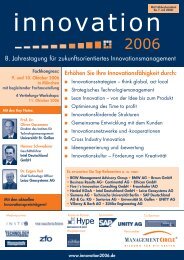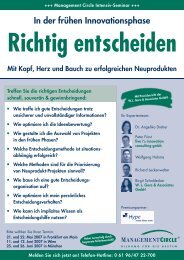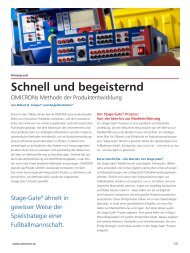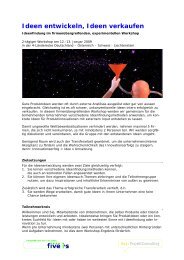The seven principles of the latest Stage-Gate
The seven principles of the latest Stage-Gate
The seven principles of the latest Stage-Gate
You also want an ePaper? Increase the reach of your titles
YUMPU automatically turns print PDFs into web optimized ePapers that Google loves.
■ Exhibit 3<br />
An overview <strong>of</strong> NexGen <strong>Stage</strong>-<strong>Gate</strong>:<br />
A five-stage, five-gate framework for significant new product projects<br />
Idea<br />
stage<br />
Idea screen<br />
<strong>Gate</strong><br />
1<br />
<strong>Stage</strong><br />
1<br />
<strong>Gate</strong><br />
2<br />
<strong>Stage</strong><br />
2<br />
Discovery Scoping Business<br />
case<br />
efforts, 55% don’t perform adequate front-end homework, and<br />
almost three-fourths lack metrics, team accountability, and continuous<br />
learning in NPD. So go through <strong>the</strong> list in Exhibit 1,<br />
and ensure that each principle becomes ingrained in your<br />
process’ language and method <strong>of</strong> operation.<br />
NexGen <strong>Stage</strong>-<strong>Gate</strong><br />
Most U.S. companies engaged in product development<br />
have adopted and implemented some form <strong>of</strong> stage-and-gate<br />
new-product processes, such as <strong>Stage</strong>-<strong>Gate</strong> (see Exhibit 3). In<br />
<strong>the</strong> APQC study, every top performing company did so, to<br />
drive new products to market. This breaks <strong>the</strong> innovation<br />
process, from idea to launch, into a series <strong>of</strong> stages (typically<br />
about five). In each stage, <strong>the</strong> project team executes a prescribed<br />
set <strong>of</strong> actions, designed to advance <strong>the</strong> project effectively<br />
and efficiently. This set is based on best practices, and<br />
yields a defined package <strong>of</strong> deliverables at <strong>the</strong> end <strong>of</strong> each<br />
stage.<br />
Each stage is preceded by a gate or go/kill decision point.<br />
Here, senior management meets with <strong>the</strong> team, and decides<br />
whe<strong>the</strong>r <strong>the</strong> project should proceed. Each gate has a prescribed<br />
list <strong>of</strong> deliverables—<strong>the</strong> information senior management<br />
needs to make <strong>the</strong> go/kill decision—and a set <strong>of</strong> go/kill<br />
and prioritization criteria, on which to base that decision.<br />
<strong>Gate</strong>s are also where team leaders secure <strong>the</strong> necessary<br />
resources for driving <strong>the</strong> project forward; <strong>the</strong>y get it on senior<br />
management’s radar screen.<br />
<strong>Stage</strong>-<strong>Gate</strong> makes sense, intuitively. It incorporates best<br />
practices that are <strong>of</strong>ten omitted in many companies’ approaches;<br />
yields focus, eliminating poor projects early in <strong>the</strong> process;<br />
makes expectations clear to project teams; encourages a crossfunctional<br />
approach to product development; and appropriately<br />
engages senior management in <strong>the</strong> innovation process as<br />
decision makers and resource providers. Moreover, when<br />
22 ❘ MM March/April 2006<br />
Driving new products to market<br />
Second screen Go to develop Go to test Go to launch<br />
<strong>Gate</strong><br />
3<br />
<strong>Stage</strong><br />
3<br />
<strong>Gate</strong><br />
4<br />
<strong>Stage</strong><br />
4<br />
<strong>Gate</strong><br />
5<br />
<strong>Stage</strong><br />
5<br />
Development Testing Launch<br />
Post launch<br />
review<br />
(PLR)<br />
properly designed and implemented,<br />
<strong>Stage</strong>-<strong>Gate</strong> works. <strong>The</strong> majority <strong>of</strong> top<br />
performing companies in product<br />
innovation—Procter & Gamble,<br />
Micros<strong>of</strong>t, Siemens, and Hewlett-<br />
Packard—have pr<strong>of</strong>iciently implemented<br />
such processes, and witnessed<br />
<strong>the</strong>ir new products going to market<br />
quickly and effectively (see <strong>the</strong> APQC<br />
study). For example, Procter & Gamble<br />
boasted five <strong>of</strong> <strong>the</strong> top 10 best-selling<br />
consumer, nonfood new-product<br />
launches in 2004. Coincidentally, it is<br />
strongly committed to SIMPL, a <strong>Stage</strong>-<br />
<strong>Gate</strong> process like <strong>the</strong> one in Exhibit 3.<br />
Companies can make <strong>Stage</strong>-<strong>Gate</strong><br />
even more effective by moving toward<br />
NexGen processes—which incorporate<br />
<strong>the</strong> six <strong>principles</strong> outlined earlier in<br />
<strong>the</strong> article—and <strong>the</strong>n adding <strong>the</strong> fol-<br />
lowing elements <strong>of</strong> <strong>the</strong> <strong>seven</strong>th principle.<br />
Lean. Smart companies streamline <strong>the</strong>ir NPD processes,<br />
removing waste and inefficiency at every opportunity. Senior<br />
management borrows <strong>the</strong> concepts from lean manufacturing<br />
and applies <strong>the</strong>m to its new-product process to remove waste<br />
in <strong>the</strong> system. By analyzing a map <strong>of</strong> <strong>the</strong> idea-to-launch value<br />
stream, all non-value-added items are removed. Every activity,<br />
procedure, template, deliverable, and committee in <strong>the</strong> current<br />
process is scrutinized: Is it really needed and how can projects<br />
be completed faster and better? Continuous learning and<br />
improvement is a key facet <strong>of</strong> <strong>the</strong> lean method, with postmortems<br />
undertaken at <strong>the</strong> post-launch review to provide<br />
insights. This results in a much more efficient and effective<br />
idea-to-launch method.<br />
Scalable. <strong>The</strong>re is no longer just one version <strong>of</strong> <strong>Stage</strong>-<strong>Gate</strong>.<br />
<strong>The</strong> process has morphed into multiple versions: <strong>Stage</strong>-<strong>Gate</strong><br />
XPress for projects <strong>of</strong> moderate risk, such as improvements,<br />
modifications, and extensions; <strong>Stage</strong>-<strong>Gate</strong> Lite for small projects,<br />
such as simple customer requests; and <strong>Stage</strong>-<strong>Gate</strong> TD for<br />
technology development projects, where <strong>the</strong> deliverable is<br />
new knowledge, new science, or a technological capability.<br />
(See Exhibit 4.)<br />
Adaptable. <strong>The</strong> notion <strong>of</strong> a rigid, lock-stepped process is<br />
dead. Today’s fast-paced NexGen <strong>Stage</strong>-<strong>Gate</strong> is flexible, allowing<br />
<strong>the</strong> project team considerable latitude in deciding what<br />
actions are really needed and what deliverables are appropriate<br />
for each gate, and adapting to fluid and dynamic information.<br />
Spiral development is one way that fast-paced teams<br />
cope with changing data while getting <strong>the</strong>ir product definitions<br />
right.<br />
In <strong>Stage</strong>-<strong>Gate</strong>, activities and stages can overlap, employing<br />
<strong>the</strong> principle <strong>of</strong> simultaneous execution: not waiting for <strong>the</strong><br />
completion <strong>of</strong> a previous step and perfect information before<br />
moving ahead. (For example, don’t wait for formal gate


